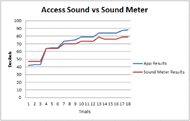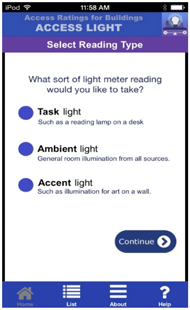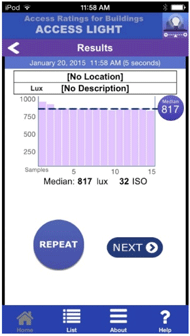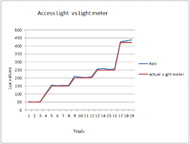SMARTPHONE-BASED LIGHT AND SOUND INTENSITY CALCULATION APPLICATION FOR ACCESSIBILITY MEASUREMENT
Nadiyah Johnson1, Piyush Saxena1, Drew Williams1, Ola Claire Bangole1, Md. Kamrul Hasan1, Sheikh Iqbal Ahamed1, and Roger O. Smith2, Dennis Tomashek2
Marquette University1, University of Wisconsin – Milwaukee2
ABSTRACT
Sufficient sound and lighting is necessary for maintaining good quality of life for people with disabilities. It is important for people to have the ability to evaluate these aspects of their environment. Unfortunately, many people do not have access to light meters or sound meters due to their bulky size and cost.
The goal of this project is to develop an easily accessible mobile phone based sound meter and light meter. The mobile application (app), Access Sound, acts as a sound meter which measures the sound level in quiet, moderate, and loud environments. The measurements are determined by a mathematical model that computes the median of the collected decibel levels in the environment. In addition, the app, Access Light, measures the level of light in the ambient, task and accent settings. Here the light level is computed using an algorithm that calculates the median lux values in the tested area. This mobile application allows disabled people to measure the accessibility of the environment based on the light or sound level information and the outcome of the app. Furthermore, both apps are designed for people with visual or hearing disabilities.
INTRODUCTION

The environmental accessibility of individuals with impaired vision and sound is significantly affected by the quality of lighting and sound in the environments that surround them. Poor quality of light and sound leads to a decrease in productivity resulting in an overall decrease in the quality of life. Many studies show the negative impacts of noise and light pollution in everyday life [1][2]. For this reason, it is imperative to quantify environmental lighting and sound levels in order to improve the quality of life of such individuals. The current generation of smartphones provides a vast array of sensors that can be used to create accessibility tools that allows them to determine the suitability of an environment for a person with impaired vision or hearing. Light Meters in today’s market are available in form of dedicated devices or software that exploits the light sensors in a smartphone. While the dedicated devices provide a higher accuracy compared to the smartphone counterparts the cost and accessibility are their primary drawbacks. Much work has been done in the recent years to improve the accuracy of both. However, there is a new medium between dedicated devices and smartphone applications that integrates a dedicated accessory with the smartphone hardware and software. Devices such and Luxi[3] and Lumu[4] are significantly cheaper than dedicated light meters and provide a more accurate lux reading compared to smartphones. These devices diffuse the incoming light providing a more accurate reading of the environmental lighting conditions. Despite the benefits, these devices add an additional cost and make the smartphone bulky. Our goal is to use a novel solution that overcomes these problems while retaining the accuracy of the measurement. Sound meters on the other hand have been dependent on smartphone hardware and software. The mobile application on smartphones today have the capability of filtering noise and providing accurate sound levels without use of external accessories. The burden of accuracy rests solely on the programming algorithms used. The projects objective is to develop a user friendly interface supported by our novel algorithm and to analyze its accuracy with industry standard dedicated sound meters.
ACCESS SOUND CONTRIBUTIONS
Algorithm 1 Sound Intensity
- Input: Type of ambient environment.
- Output: Sound intensity.
-
Initialization
a=Duration of sound analysis, b = 15% a, c=a-b, and d=15+c
- For j=0 to d/a do the following
- Set minimum decibel threshold
- minDecibels = - 60.0 f;
- Call iOS API to capture 100 samples
- For i=0 to 100 do the following
- [Recorder updateMeters];
- Decibels = [recorder averagePowerChannel:0]+decibels
- End For
- End For
- Calculate the average decibels=(Decibels/100)
- If decibels < minDecibels Then
- Level = 0.0 f
- Calculate the sound intensity having I = 1.8
- Decibels = I * (decibels + 85 )
- Based on sound level selected by the user(quiet, moderate, loud) the decibel value is multiplied by a percentage
- If AppDelegate.value == Quiet Then
- decibels = decibels * 0.50
- If AppDelegate.value == Moderate Then
- decibels = decibels * 0.80
- If AppDelegate.value == Loud Then
- decibels = decibels * 0.90
-
The decibel value is placed into an arrayappdelegate.soundArray [j+(mainInt*d/a)] = decibels ;
Technical Background

Considering accuracy and reliability, we have selected iOS device for developing our mobile application and for testing the performance of algorithm. Access Sound mobile application can emulate the functionality of SLM devices using the available hardware and software in iOS devices.
ACCESS SOUND ALGORITHM

This value is then multiplied by a percentage value based on the environment level selected by the user. The sound intensity is then stored in an array. The algorithm stores fifteen values into the array and displays the median of these values to the user as shown in Figure 2. The Algorithm is detailed in the following section.
Method of Testing

Results:
Functionality
The mobile app Access Sound is unique because it not only measures the sound level in an environment but also provides the accessibility level of the environment to the user. The accessibility level indicates how useful or convenient the environment is for certain activities. For instance, if the noise level is potentially hazardous then it notifies the user that the environment is not conducive for certain activities. This is particularly helpful for people with disabilities who are not able to properly estimate the sound level in a room.
| 1 | App Results | Sound Meter Results | Percent error |
| 2 | 42 | 47 | 10.64 |
| 3 | 43 | 47 | 8.51 |
| 4 | 43 | 47 | 8.51 |
| 5 | 64 | 64 | 0 |
| 5 | 55 | 64 | 1.55 |
| 7 | 5 | 64 | 1.55 |
| 8 | 73 | 70 | 4.29 |
| 9 | 74 | 70 | 5.71 |
| 10 | 75 | 70 | 7.14 |
| 11 | 79 | 73 | 8.22 |
| 12 | 79 | 73 | 8.22 |
| 13 | 79 | 73 | 8.22 |
| 14 | 84 | 79 | 6.33 |
| 15 | 84 | 76 | 10.53 |
| 16 | 84 | 76 | 10.53 |
| 17 | 84 | 76 | 10.53 |
| 18 | 87 | 79 | 10.13 |
ACCESS LIGHT CONTRIBUTION
Algorithm 2
Input:
Output:
- The ISO, exposure time and Brightness Value of each image is retrieved and placed into an equation which calculates the lux value displayed to the user.
- First the continuous auto exposure is initialized for the camera
- If [deviceisExposureModeSupported:AVCaptureExposureModeContinuousAutoExposure] Then
- Make the focus point the center of the image
CGPoint exposurePoint = CGPointMake(0.5f, 0.5f);
[device setExposurePointOfInterest:exposurePoint]; - [device
- setExposureMode:AVCaptureExposureModeContinuousAutoExposure];
- Multiple image samples are taken
- NSData *imageData = [AVCaptureStillImageOutput jpegStillImageNSDataRepresentation:imageSampleBuffer];
- UIImage *image = [[UIImage alloc] initWithData:imageData]; UIImageWriteToSavedPhotosAlbum (image, nil, nil , nil);
- Set Brightness value, Exposure time and ISO values
- double BrightnessValue = [[dict objectForKey:@"BrightnessValue"] doubleValue];
- double ExposureTime = [[dict objectForKey:@"ExposureTime"] doubleValue];
- int ISOSpeedRatings = [[[dict objectForKey:@"ISOSpeedRatings"] objectAtIndex:0] integerValue];
- Calculate Lux value
- double luxAmount =(112*pow(1.92,BrightnessValue)/(0.0929/ExposureTime));
Technical Light Meter tools
Light meter devices calculate the lux values for any environment. Lux is the unit of illuminance and luminous emittance. Light meters can measure incident and reflected light levels within the area. Incident light is the light that an object is exposed to and it comes from the source of the light. Again, reflected light is the light that is reflected from the object. Professional light meters use a dome to capture the widest angle of light. Once the lux value is calculated a digital output is presented to the user. The standard method used for algorithm to calculate lux is given in the following [6].
Where, E is luminance in lx, k is shutter, t is shutter speed, and ISO is film speed. The mobile application (Access Light) functions to emulate professional light meters using the hardware and software provided by iOS devices.

ACCESS LIGHT ALGORITHM
The ISO, shutter speed and aperture are the three main parameters that play a vital role in the Access Light Algorithm. The ISO speed controls sensor sensitivity to the light. The Aperture is the camera lens that controls the amount of light comes to the image sensor. Finally, the shutter speed controls the time limit of the aperture to remains open. The Access Light app allows the user to put the input selecting task light, ambient light or accent light shown in Figure 4. [7] [8]. Their selection will affect the sound level calculation in our algorithm. The algorithm uses the method of continuous auto exposure which is provided by iOS API to conjunctly use these aforementioned parameters to produce accurate lux values. The Algorithm is described in the following section.
Testing Accuracy:

Results:
| App | actual -Light meter | Percent Error |
|---|---|---|
| 52 | 50 | 4 |
| 50 | 50 | 0 |
| 52 | 50 | 4 |
| 105 | 100 | 5 |
| 155 | 150 | 3.33 |
| 152 | 150 | 1.33 |
| 153 | 150 | 2 |
| 153.3333333 | 150 | 2.222222222 |
| 2.1 | 2 | 5 |
| 2:05 | 2 | 2.5 |
| 2:03 | 2 | 1.5 |
| 2:05 | 2 | 3 |
| 255 | 250 | 2 |
| 2.5 | 250 | 4 |
| 253 | 250 | 1.2 |
| 255 | 250 | 2.4 |
| 42.5 | 422 | 0.95 |
| 433 | 422 | 2.61 |
| 439 | 422 | 4.028435019 |
Functionality
Access Light provides the user with the lux values of the area. It also provides the accessibility level of the environment to the user. Calculating the lux value, mobile app warns the user based on the threshold value. The app also can alert the user on the amount of light that may not be suitable for certain activities. This is particularly helpful for visually disable people who are not able to accurately measure the light in a room.
CONCLUSION
This paper documents innovative approaches to measuring sound and light from an ambient environment. Access Sound and Access Light are mobile applications that inform the user of the accessibility of their current location by providing useful sound and light measurements. These applications are extremely useful for the users having visual and audio impairments.REFERENCES
[1] S. A. Stansfeld and M. P. Matheson, "Noise pollution: non-auditory effects on health," British Medical Bulletin, vol. 68, pp. 243-257, 2003 .
[2] F. Falchia, P. Cinzanoa, C. D. Elvidgeb, D. M. Keithc and A. Haimd, "Limiting the impact of light pollution on human health, environment and stellar visibility," Journal of Environmental Management, vol. 92, p. 2714–2722, 2011.
[3] "Extrasensory Devices," [Online]. Available: http://www.esdevices.com/products/luxi. [Accessed January 2015].
[4] "Lumu," [Online]. Available: http://lumu.eu/lightmeter/. [Accessed January 2015].
[5] J. Hillhouse, "Basic sound level knowledge for electric motor application," Petroleum and Chemical Industry Conference (PCIC), 2010 Record of Conference Papers Industry Applications Society 57th Annual, pp. 1-8, 2010.
[6] A. Ismail, M. Azmi, M. Hashim, M. Ayob, M. Hashim and H. Hassrizal, "Development of a webcam based lux meter," Computers & Informatics , pp. 70-74, 2013.
[7] N. Negar, D. Williams, J. Schwartz, S. Ahamed, and R.Smith, Marquette University, University of Wisconsin - Milwaukee. "Smartphone-Based Light Intensity Calculation Application For Accessibility Measurement," RESNA, 2014.
[8] F. Rahman, C. Brien, C. Ostberg, N.Negar, D. Do, S.Ahamed, R.Smith, Marquette University, University of Wisconsin - Milwaukee, "Smartphone Based Solutions To Measure The Built Environment & Enable Participation," RESNA Annual Conference, 2013.
ACKNOWLEDGMENTS
The AR-B Project is supported in part by the Department of Education, National Institute on Disability and Rehabilitation Research (NIDRR), grant number H133G100211. The opinions contained in this proceeding do not necessarily represent the policy of the U.S. Department of Education, and you should not assume endorsement by the Federal Government.